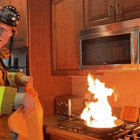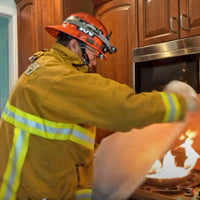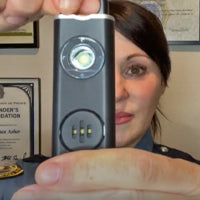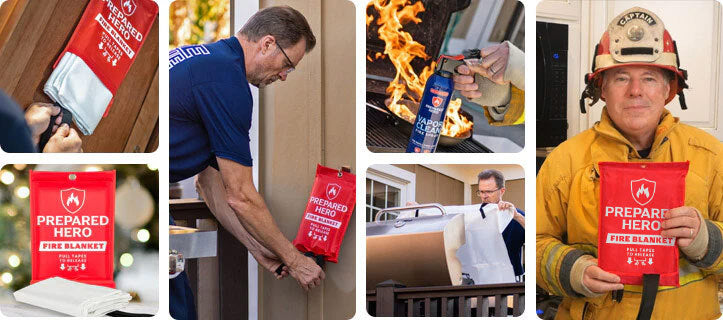Where you put your smoke detectors matters just as much as installing them. Proper placement makes sure they can detect...
Smoke alarms cut the risk of dying in a home fire by about 60%, according to the National Fire Protection Association (NFPA). But they need working batteries to do their job.
After all, dead or missing batteries are one of the top reasons smoke alarms fail during a fire. So, knowing how to check and change your smoke alarm battery is a must. Whether you’ve got a battery-powered unit or a hardwired one with backup batteries, here’s what you need to know to keep your home safe.
Battery-Operated vs. Hardwired Smoke Alarms

Battery-operated and hardwired smoke detectors are the two main types of alarms based on power source. Here are the differences between them:
Installation
Battery-operated alarms are easy to install. Just screw them to the ceiling or wall and pop in the batteries, no wiring needed. On the other hand, hardwired smoke alarms require more work. They have to be connected to your home’s electrical system, which calls for an electrician.
Power Source
Battery-operated alarms run only on batteries. If the battery dies or gets removed, the alarm won’t work. On the flip side, hardwired smoke detectors get power from your home’s electrical system. They also have backup batteries in case the power goes out.
Maintenance
Battery-operated alarms need regular battery checks and replacements unless they have sealed 10-year batteries. On the other hand, hardwired detectors need less maintenance. However, you have to check the wiring, breaker, or power source when there’s an issue.
Interconnectivity
Battery-operated alarms work alone. So, if one goes off, the others stay silent. On the other hand, hardwired alarms are interconnected. So, if one detects smoke, the other alarms go off.
Reliability
Battery-operated alarms can fail if batteries die or aren’t replaced. On the flip side, hardwired detectors always have power since they’re connected to your home’s electrical system and have backup batteries.
Cost
Battery-operated alarms are more affordable. Hardwired alarms cost more upfront and include electrician fees.
How to Change Your Smoke Alarm Battery

Changing your smoke alarm battery isn’t complicated. If your smoke alarm is chirping or it’s been about a year since your last battery change, it's time to swap it out. Here’s how to do it:
1. Find the Alarm That Needs a New Battery
A beeping smoke detector usually means the battery is low. Determine which smoke alarm is chirping and see if it needs a battery change.
2. Remove the Alarm from the Mount
Once you find the alarm that needs new batteries, remove it from its mounting plate. Turn the alarm counter-clockwise or clockwise. If yours has a locking tab or tamper-resistant feature, you might need a screwdriver to remove the smoke alarm.
3. Replace the Battery
Next, open the battery compartment. It’s usually on the back or front of the alarm. Remove the old battery and insert a new one. Make sure the positive (+) and negative (–) sides match the markings. If your alarm needs two batteries, replace both at the same time.
4. Test the Alarm
Press and hold the test button before putting the smoke alarm back. If it beeps loudly, you’re good to go. If nothing happens, open the battery compartment and make sure the battery is properly aligned.
5. Reinstall the Alarm
Line it up with the bracket on the ceiling and twist it counter-clockwise or clockwise until it clicks into place. That’s it.
How Often Should You Replace Smoke Alarm Batteries?

Changing your smoke alarm battery doesn’t take long, but it helps keep your home safe. According to the NFPA, you should change your smoke alarm battery at least once a year. So, mark your calendar to check the batteries every 12 months or sooner if your detector chirps.
How Do I Stop My Smoke Detector From Chirping?

Is your smoke detector beeping without a real threat? It’s annoying, right? But we have some good news: it’s usually easy to fix. Here’s how to stop your smoke detector from chirping:
1. Change the Battery
Most of the time, the chirping means the battery is low. Remove the detector from its mount, open the battery compartment, and change the batteries. Then, press the test button to make sure it’s working.
2. Reset the Alarm
Try resetting your smoke alarm if it’s still chirping after changing the battery. Just press and hold the test button for 15 to 30 seconds. You should hear a beep. This usually clears it.
3. Clean It
Dust and bugs can mess with the sensor. Take the detector down and blow it out with some compressed air. Then, wipe the outside with a dry cloth. Don’t use water or spray cleaners.
4. Watch the Environment
Alarms near steamy bathrooms or busy kitchens can beep more often. Try moving it a bit farther from those spots. Big temperature changes can also cause false alarms.
5. It Might Be Old
If your chirping smoke alarm is near or over 10 years old, it might be time for a new one. Like other fire prevention tools, smoke detectors don’t last forever. Find out more about how to stop a smoke detector from beeping unnecessarily here.
Can You Change Smoke Alarm Batteries Yourself?

Yes, you can change smoke alarm batteries yourself. It’s easy and only takes a few minutes.
First, find the detector that’s chirping or due for a battery change. Then, twist the alarm off its mount. Some might need a screwdriver if there's a locking tab.
Open the battery compartment that’s usually found on the front or back. Take out the old battery and pop in a new one, matching the positive (+) and negative (–) signs with the markings inside.
Press and hold the test button next. It’s good to go once it beeps. Lastly, twist the alarm back onto the ceiling mount until it clicks.
How Do You Remove the Battery From a Smoke Alarm That’s Still Chirping?
Smoke alarms can store a small residual charge. Press and hold the test or reset button for about 30 seconds. This should drain the charge and stop the chirping. You can change the battery once the chirping stops. If it keeps chirping after that, double-check the battery placement or consider replacing the unit if it’s near or over 10 years old.
How Often Should You Test Your Smoke Alarm?

You should test your smoke alarm once a month. It takes less than a minute and makes sure it’ll work when needed. Just press the test button. If it sounds loud and clear, your smoke alarm is working. If not, replace the battery or the whole unit. You should also test your smoke alarm after cleaning it or changing the battery.
How Long Will a Smoke Detector Chirp Before It Dies?
A battery-smoke detector will usually chirp for about a month before it dies. On the other hand, a hardwired smoke detector will usually keep on chirping until the backup battery is replaced. It’s because the said smoke alarm is connected to your home’s electrical system. The chirping sound usually occurs every minute and can continue for at least a week even after the main battery is drained.
Why Does My Smoke Detector Keep Chirping Even After I Change the Battery?

Your smoke detector keeps chirping even after you change the battery because it might not be replaced properly, there’s residual charge, dust and debris accumulated in it, humidity and steam are messing with the sensors, or the unit is old and malfunctioning.
First, check if the new battery is installed correctly and fits snugly. A loose or misaligned battery can cause chirping. Next, try resetting the smoke alarm. Hold the test or silence button for about 30 seconds. This clears the leftover charge from the old battery.
Dust and debris are another common reason. If the sensor is dirty, your smoke alarm can act up. Gently vacuum the detector or use compressed air to clean it. Humidity and steam can also cause random beeping.
But if you’ve checked everything and it’s still chirping, the smoke alarm might be faulty. This might be because the unit is near or over 10 years old. Sometimes, replacing the whole thing is the easiest fix.
Random chirps are annoying, but don’t ignore them. That chirp is your smoke detector asking for help, and your and your loved ones’ safety depends on it.
Why Does a Hardwired Smoke Detector Chirp?
A hard-wired smoke detector chirps because of a dead backup battery, dust buildup, old age, a malfunction, or residual charge.
One of the most common reasons why a hardwired smoke detector chirps is a dead backup battery. Even though the unit is wired into your home’s power, it still relies on a battery during outages. So when that battery runs low, the detector chirps until you replace it.
Dust is another common cause. Over time, particles can build up inside the smoke detector and mess with its sensor. This buildup can trigger random beeping or false alarms. Cleaning the unit with a soft brush or vacuum usually helps.
Is the battery is new and the unit is clean, but still chirping? Check how old the detector is. Smoke alarms don’t last forever and have to be replaced every ten years. If yours is over a decade old, it’s time to replace it.
Sometimes, the detector just needs a reset. Try holding down the test button for about 30 seconds to drain any leftover charge from the old battery.
If you’ve tried all of the above and the chirping won’t stop, it might be a malfunction. If this is the case, replace the alarm or call a technician to inspect it.
Where Is the Hush Button on a Smoke Detector?

The hush button on a smoke detector is usually right on the front or side of the device. It might be labeled “Hush,” “Silent,” or “Test.” If you’re not sure, check the user manual. It will tell you exactly where to find it.
Conclusion
Keeping your smoke alarm in top shape is one of the best ways to protect your home and loved ones. Changing the battery at least once a year and testing it monthly don’t take much of your time.
But don’t stop there. Pair your smoke alarms with other fire prevention tools like fire extinguishers, fire blankets, fire sprays, and flame shields. Remember, detecting fire is just one piece of the puzzle.
Do you want reliable, easy-to-use, and affordable tools to put out small fires before they spread? Check out Prepared Hero’s fire prevention tools here, and get up to 51% off on certain items. Stay prepared, hero!


 Fire
Fire Safety
Safety Survival
Survival Protection
Protection New
New
 Fire
Fire Safety
Safety Survival
Survival Protection
Protection New
New












